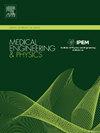Physiological consequences of half-embedded drug-eluting stent on coronary drug-transport: A two-species drug delivery simulation
IF 1.7
4区 医学
Q3 ENGINEERING, BIOMEDICAL
引用次数: 0
Abstract
Drug-eluting stent (DES) is commonly utilized to open blocked arteries and reduce in-stent restenosis (ISR) brought on by the implantation of bare-metal stent (BMS). The current mathematical model sheds light on investigating the physiological effects of different clinical parameters on drug distribution and retention within the artery wall. A two-dimensional (2D) axisymmetric cylindrical model of a typical Palmaz stent having circular struts coated with a bio-durable polymer is half-embedded in the tissue. This investigation considers two distinct drug phases - the unbound and bound phases - in the artery wall. The artery wall is considered a porous medium, and the Brinkman equation governs the interstitial fluid (ISF) flow within it. An unsteady convection-diffusion-reaction mechanism governs unbound drug transport, while that of bound drug is solely controlled by an unsteady chemical reaction. The drug delivery system also includes a reversible equilibrium mechanism to maintain the chemical reaction between the drug molecules and the receptors. Drug and momentum transport equations are solved using the Marker-and-Cell (MAC) method in staggered grid setups with appropriate initial and boundary conditions. According to simulations, there is going to be a bi-phasic decrease in unbound drug in the artery wall with a larger binding-on constant (ψ), and the concentration of both drug forms and the area under concentration decrease as the Peclet number (Pe) increases. Additionally, as the equilibrium association constant () increases, the concentration of the unbound drug decreases, but the tendency for the bound drug is reversed. The sensitivity of some significant parameters has been examined in a thorough sensitivity study. Our results are in excellent agreement with the findings available in the literature.
半嵌入式药物洗脱支架对冠状动脉药物传输的生理影响:双种药物输送模拟
本文章由计算机程序翻译,如有差异,请以英文原文为准。
求助全文
约1分钟内获得全文
求助全文
来源期刊

Medical Engineering & Physics
工程技术-工程:生物医学
CiteScore
4.30
自引率
4.50%
发文量
172
审稿时长
3.0 months
期刊介绍:
Medical Engineering & Physics provides a forum for the publication of the latest developments in biomedical engineering, and reflects the essential multidisciplinary nature of the subject. The journal publishes in-depth critical reviews, scientific papers and technical notes. Our focus encompasses the application of the basic principles of physics and engineering to the development of medical devices and technology, with the ultimate aim of producing improvements in the quality of health care.Topics covered include biomechanics, biomaterials, mechanobiology, rehabilitation engineering, biomedical signal processing and medical device development. Medical Engineering & Physics aims to keep both engineers and clinicians abreast of the latest applications of technology to health care.
 求助内容:
求助内容: 应助结果提醒方式:
应助结果提醒方式:


